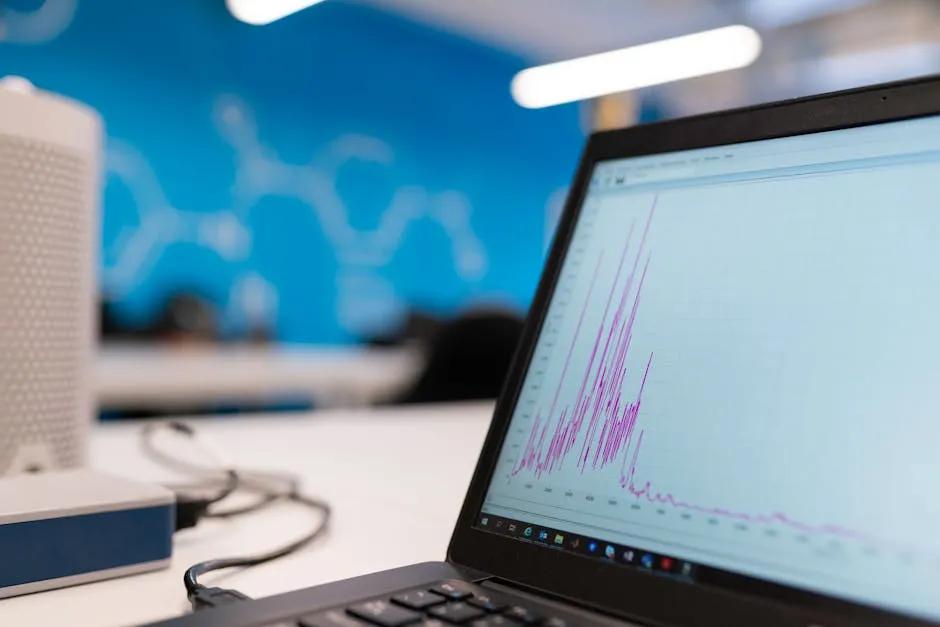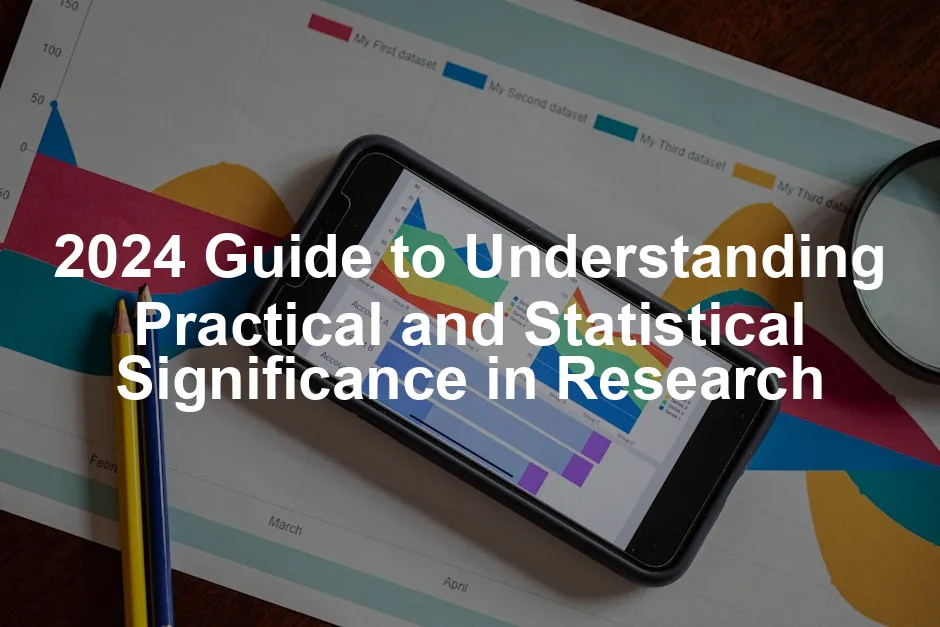Introduction
In the world of research, understanding the difference between practical and statistical significance is like navigating a labyrinth with two exits: one leads to meaningful conclusions and the other to misleading results. As we step into 2024, researchers, data analysts, and decision-makers must equip themselves with the knowledge to decode these concepts. Statistical significance tells us whether our results are likely due to chance, while practical significance asks if those results matter in real-world applications. This article will guide you through the intricacies of both, ensuring that you not only find significant results but also understand their implications.
Imagine you’ve conducted a study, and the p-value shouts, “Statistically significant!” But pause for a moment. Does this finding mean anything in the grand scheme of things? Or is it just a shiny bauble, glinting under the spotlight of data? The answer lies in understanding both statistical and practical significance.
Statistical significance is often represented by p-values, which indicate the likelihood that an observed effect is genuine rather than a product of random chance. A p-value less than 0.05 usually signals that it’s safe to reject the null hypothesis (the idea that nothing is happening). But here’s the twist: just because a result is statistically significant doesn’t mean it’s practically important.
Let’s take an example. A new medication reduces symptoms by a statistically significant 0.5%. Sounds promising, right? But in reality, that’s barely a drop in the bucket for patients. This is where practical significance steps in, asking, “Does this change improve lives?”
In this guide, we’ll peel back the layers on both types of significance, illustrating their importance with engaging anecdotes and real-world examples. You’ll learn how to interpret results correctly, avoid common pitfalls, and ensure your research creates a tangible impact. So, buckle up! We’re about to embark on an enlightening journey through the fascinating world of significance in research.

Summary of Key Points
1. Statistical Significance: Defined as the likelihood that a result is not due to random chance, typically assessed with p-values.
2. Practical Significance: Focuses on the real-world relevance of a statistically significant finding, considering effect sizes and their implications.
3. Importance of Sample Size: Larger samples can yield statistically significant results, but may not always indicate practical importance.
4. Interpreting P-values: Understanding what p-values represent and common misconceptions surrounding them.
5. Confidence Intervals: Provides context for the precision of estimates and helps assess both statistical and practical significance.
6. Common Misinterpretations: Highlighting the pitfalls in understanding significance, including p-hacking and overemphasis on p-values.
7. Applications Across Fields: How both types of significance apply in various disciplines, from healthcare to business analytics.
8. Best Practices for Researchers: Strategies for ensuring robust research designs that consider both statistical and practical significance.
Understanding these key points will not only sharpen your research skills but also empower you to make informed decisions that resonate in the real world. Let’s dive deeper into the concepts of statistical and practical significance to unlock their full potential!

Understanding Statistical Significance
Definition and Importance
Statistical significance is a cornerstone of research, helping us determine if our findings are genuine or mere coincidences. When researchers conduct experiments, they often start with a hypothesis. This hypothesis predicts a relationship or effect. The null hypothesis posits that there’s no effect or relationship at all. If our observations contradict this null hypothesis, we declare our results statistically significant.
At the heart of this process is the p-value. A p-value indicates the probability of observing results as extreme as those measured, assuming the null hypothesis is true. For instance, a p-value of 0.03 suggests there’s only a 3% chance our results are due to random fluctuations. Typically, a p-value below 0.05 is considered statistically significant, allowing researchers to confidently reject the null hypothesis.
Why is this important? Statistical significance serves as a gatekeeper for scientific findings. It ensures that researchers rely on data that genuinely reflects effects, rather than random noise. This validation is crucial for making informed decisions, whether in medicine, business, or any other field.
Common statistical tests, like t-tests and ANOVA, help determine significance. T-tests compare means between two groups, while ANOVA extends this to three or more groups. For example, if a new drug claims to lower blood pressure, researchers may use a t-test to compare the drug’s effects on a treatment group versus a control group. If the p-value is low, the drug’s effect is statistically significant.
Understanding how to calculate p-values is essential. Researchers select a significance level (alpha), often set at 0.05, before conducting tests. They gather data, analyze it, and then compute the p-value. If it falls below the alpha, they reject the null hypothesis. This systematic approach provides a clear framework for interpreting research findings.

For those looking to deepen their understanding of statistical methods, consider picking up a copy of Practical Statistics for Data Scientists. This book is a great resource for grasping essential concepts that will make your research more robust and insightful.
Common Misconceptions
Statistical significance is frequently misunderstood. One prevalent misconception is that a low p-value guarantees the null hypothesis is false. In reality, a p-value only indicates the likelihood of observing the data if the null hypothesis holds true. It does not confirm the truth of the alternative hypothesis.
Another common pitfall is equating statistical significance with practical importance. A statistically significant result does not necessarily mean it has real-world relevance. For instance, a study might find a statistically significant reduction in blood pressure of 0.5 mmHg with a new medication. While the result is significant, the practical impact on patient health could be negligible. If you’re interested in understanding more about the intersection of statistics and practical applications, check out The Art of Statistics: Learning from Data.
Moreover, many believe that a non-significant p-value suggests no effect exists. This is misleading; it simply means the evidence isn’t strong enough to reject the null hypothesis. Just because a result isn’t statistically significant doesn’t mean it’s unimportant.
Lastly, researchers often misinterpret the implications of p-values. A common belief is that the p-value tells us the probability the null hypothesis is true. This is not the case. Instead, it reflects the probability of observing the data given the null hypothesis is accurate. Understanding these nuances is vital for accurate interpretation.

Significance Testing Process
Conducting significance tests involves several steps. First, define the hypotheses. The null hypothesis (H0) states there is no effect, while the alternative hypothesis (H1) suggests there is one.
Next, choose your significance level, commonly set at 0.05. This level represents the maximum probability of making a Type I error, which occurs when we incorrectly reject a true null hypothesis.
After establishing these parameters, it’s time to collect and analyze your data. Depending on your study design, you might use various statistical tests. For instance, if you’re comparing two means, you’d likely employ a t-test. If you’re evaluating more than two groups, ANOVA might be the appropriate choice.
Once you calculate the test statistic, you’ll obtain a p-value. Compare this p-value against your significance level. If it’s less than or equal to the alpha, you reject the null hypothesis. This indicates that the observed effect is statistically significant.
Finally, contextualize your results. Statistical significance alone is insufficient. Researchers must consider the practical implications of their findings. A statistically significant result should prompt further investigation into its real-world relevance, ensuring that research leads to meaningful conclusions.
For those of you who love diving into data analysis with tools like R, a great resource is R for Data Science. This book will help you harness the power of R for effective data analysis.

Common Misconceptions
Statistical significance is frequently misunderstood. One prevalent misconception is that a low p-value guarantees the null hypothesis is false. In reality, a p-value only indicates the likelihood of observing the data if the null hypothesis holds true. It does not confirm the truth of the alternative hypothesis.
Another common pitfall is equating statistical significance with practical importance. A statistically significant result does not necessarily mean it has real-world relevance. For instance, a study might find a statistically significant reduction in blood pressure of 0.5 mmHg with a new medication. While the result is significant, the practical impact on patient health could be negligible.
Moreover, many believe that a non-significant p-value suggests no effect exists. This is misleading; it simply means the evidence isn’t strong enough to reject the null hypothesis. Just because a result isn’t statistically significant doesn’t mean it’s unimportant.
Lastly, researchers often misinterpret the implications of p-values. A common belief is that the p-value tells us the probability the null hypothesis is true. This is not the case. Instead, it reflects the probability of observing the data given the null hypothesis is accurate. Understanding these nuances is vital for accurate interpretation.

Significance Testing Process
Conducting significance tests involves several steps. First, define the hypotheses. The null hypothesis (H0) states there is no effect, while the alternative hypothesis (H1) suggests there is one.
Next, choose your significance level, commonly set at 0.05. This level represents the maximum probability of making a Type I error, which occurs when we incorrectly reject a true null hypothesis.
After establishing these parameters, it’s time to collect and analyze your data. Depending on your study design, you might use various statistical tests. For instance, if you’re comparing two means, you’d likely employ a t-test. If you’re evaluating more than two groups, ANOVA might be the appropriate choice.
Once you calculate the test statistic, you’ll obtain a p-value. Compare this p-value against your significance level. If it’s less than or equal to the alpha, you reject the null hypothesis. This indicates that the observed effect is statistically significant.
Finally, contextualize your results. Statistical significance alone is insufficient. Researchers must consider the practical implications of their findings. A statistically significant result should prompt further investigation into its real-world relevance, ensuring that research leads to meaningful conclusions.
In the realm of statistical software, SPSS is a tool that can assist researchers in conducting thorough statistical tests efficiently.

Understanding Practical Significance
Definition and Relevance
Practical significance is the real-world importance of research findings. It answers the crucial question: “Does this result matter?” Unlike statistical significance, which merely indicates that a result is unlikely due to chance, practical significance digs deeper into the implications of those results. For researchers and practitioners alike, grasping practical significance is essential. It ensures that findings lead to meaningful changes, rather than just statistical artifacts.
Measuring practical significance often involves calculating effect sizes. Effect sizes quantify the magnitude of a phenomenon, providing a clearer picture of its importance. For example, in psychological research, Cohen’s d is a common measure that tells us how far apart two group means are in standard deviation units. A small Cohen’s d (around 0.2) suggests a trivial effect, while a medium (0.5) or large (0.8) d indicates substantial significance. This information is invaluable across various fields, from medicine to education, because it helps guide decisions based on evidence rather than mere numerical outputs.
In healthcare, for instance, a new treatment might show a statistically significant improvement in patient outcomes. However, if the effect size is small, the treatment may not be worth the costs or risks involved. Understanding practical significance assists healthcare providers in choosing interventions that genuinely improve patient quality of life.

If you’re looking for a comprehensive guide on data science that also touches on practical significance, consider The Data Science Handbook. It’s packed with insights that will elevate your understanding of data’s role in real-world applications.
Effect Size vs. Statistical Significance
Effect sizes and statistical significance serve different purposes in research. While statistical significance tells us whether an effect exists, effect sizes reveal the strength of that effect. For example, let’s consider a clinical trial for a new medication. The trial could yield a statistically significant p-value of 0.03, suggesting the drug works better than a placebo. But if the effect size is a minuscule 0.1, the clinical relevance becomes questionable.
To illustrate this further, let’s look at a couple of case studies. In one study, a new anxiety medication reduced symptoms by a statistically significant 10%. However, the effect size was only 0.15, indicating minimal practical significance. In contrast, another study showed a new therapy reduced symptoms by only 5%, but with an effect size of 0.8. The latter finding, though smaller in percentage, suggests a meaningful impact on patients’ lives.
Thus, the distinction between effect size and statistical significance is crucial. Relying solely on statistical significance can lead to misleading conclusions, emphasizing the need for comprehensive evaluations that include effect size.

Contextualizing Results
When interpreting research findings, context is paramount. Practical significance cannot be assessed in isolation; it must be considered within the specific field and circumstances of the study. For instance, in healthcare, a 1% improvement in patient recovery rates might be insignificant in the context of a life-threatening illness. However, the same percentage might be groundbreaking in a field like education, where small changes can lead to substantial improvements over time.
In education, studies may show statistically significant improvements in test scores due to a new teaching method. However, if the actual score increase is negligible—say, just 0.5 points—the practical implications may not justify the method’s implementation.
In business, companies often assess the practical significance of marketing campaigns. A campaign might lead to a statistically significant increase in sales. However, if the increase is just a few dollars per unit sold, it may not warrant the campaign’s costs.
By using real-world examples from various sectors, researchers can illustrate practical significance in action, reinforcing the importance of context. The implications of research findings should always extend beyond mere statistical numbers, guiding decisions that have tangible impacts on people’s lives.

Factors Affecting Statistical and Practical Significance
Sample Size and Variability
Sample size is like the secret ingredient in the recipe of research. A larger sample size usually boosts the chances of finding statistically significant results. Why? Because bigger samples provide more accurate estimates of the population, reducing the margin of error. Imagine trying to guess the average height of a group of friends. If you only ask one friend, your guess is shaky at best. Ask ten friends, and you might get a clearer picture.
On the flip side, small sample sizes can lead to misleading conclusions. They may yield statistically significant results that are not practically significant. For example, a study might find a new therapy leads to a 1% improvement in recovery rates in a small group of patients. Statistically significant? Yes. Practically significant? Not so much.
Variability within the data also plays a crucial role. High variability can mask true relationships between variables. If your sample has a wide range of responses, it becomes harder to detect genuine effects. Consider a study measuring the impact of a motivational seminar on productivity. If productivity scores vary widely among participants, it could obscure any real impact of the seminar. Therefore, controlling variability is essential for interpreting results appropriately.

Multiple Comparisons and P-Hacking
Welcome to the world of multiple comparisons, where researchers must tread carefully. When you conduct several tests simultaneously, the risk of encountering false positives increases. Picture a carnival game where you toss rings over bottles. If you throw enough rings, you’re bound to land one eventually, even if you’re just lucky. This is the multiple comparisons problem.
To combat this, researchers often employ corrections, such as the Bonferroni correction, to adjust significance levels. This means multiplying the original alpha level by the number of tests performed. It’s a way to keep the circus under control and avoid claiming significance where there is none.
Then there’s p-hacking, the sneaky cousin of multiple comparisons. Researchers might manipulate data or analysis methods until they achieve a statistically significant result. This practice undermines the integrity of research. It’s like a magician pulling a rabbit out of a hat—impressive, but not entirely ethical. To maintain research integrity, transparency is key. Pre-registering studies and using robust methods can help researchers avoid falling into this trap.

Reporting and Transparency
The way researchers report their findings can make or break the understanding of statistical and practical significance. Best practices include clearly stating the sample size, methodology, and the results of statistical tests. This transparency allows peers to evaluate the robustness of the findings.
Moreover, context matters. Researchers should explain what their results mean in real-world terms. For instance, if a new medication shows a statistically significant reduction in symptoms, it’s essential to discuss whether that reduction is large enough to affect patient care.
Using visuals, such as graphs and tables, can also enhance clarity. They help readers quickly grasp complex data and see the practical implications of the findings.
In an era where misinformation can spread like wildfire, transparency in research is paramount. Clear communication ensures that results are not misinterpreted, paving the way for informed decision-making. By adhering to these best practices, researchers can contribute to a clearer understanding of both statistical and practical significance, fostering a more trustworthy research environment.

Best Practices for Researchers
Designing Robust Studies
Creating a robust study is like crafting a fine dish—it requires the right ingredients and careful preparation. First, researchers must establish clear objectives that address both statistical and practical significance. Start with a well-defined hypothesis. This is your guiding star, helping you focus your research efforts.
Next, a pre-study power analysis is essential. This analysis determines the sample size needed to detect a meaningful effect if it exists. Think of power analysis as your research’s safety net. It provides the confidence that your study is not too small to detect significant results. A larger sample size generally reduces the risk of Type I and Type II errors. However, be mindful—too large of a sample can lead to detecting trivial differences that hold little practical value.
A well-designed study also incorporates randomization, blinding, and control groups. Randomization minimizes bias, while blinding ensures that participant expectations do not influence outcomes. Control groups serve as a benchmark, allowing you to compare results effectively. By combining these elements, researchers can create studies that yield reliable, meaningful insights.
Speaking of insights, if you’re interested in honing your statistical skills further, don’t miss out on Statistics for Dummies. It’s a humorous and accessible guide that will make you feel like a statistics wizard!

Communicating Findings
Once the study wraps up, it’s time to share the findings. But here’s the catch—most people aren’t statisticians. So, how do you communicate complex results to non-technical audiences? Start with the big picture. Summarize the key findings in simple language, avoiding jargon that could alienate readers.
Visuals are your best friends in this endeavor. Use graphs and charts to illustrate results clearly. A well-designed bar chart can convey differences in means more effectively than a dense paragraph of text. Remember, a picture is worth a thousand words, especially when presenting statistical data.
It’s also vital to discuss the practical implications of your findings. Explain how your results can influence real-world decisions or practices. This approach not only engages your audience but also emphasizes the significance of your research in everyday life.
If you’re looking for tools to aid in your data visualization efforts, consider Tableau. It’s a powerful tool that can help you present your data in visually appealing ways.

Continuous Learning and Adaptation
The world of statistics is ever-evolving, and so should your knowledge. Researchers need to stay updated on the latest statistical practices and methodologies. The landscape shifts rapidly, with new techniques and tools emerging regularly. Embrace a mindset of continuous learning.
There are plenty of resources available. Books like Introduction to the Practice of Statistics provide foundational knowledge, while online courses on platforms like Coursera and edX offer up-to-date training on statistical techniques. Workshops and conferences can also provide invaluable networking opportunities and insights into cutting-edge research.
Additionally, consider joining professional organizations related to your field. These groups often offer access to journals, newsletters, and forums where you can engage with other researchers. By staying informed, you can adapt your methodologies and ensure your research remains relevant and impactful.

Conclusion
Understanding both practical and statistical significance is crucial for researchers in 2024. As data-driven decision-making continues to shape various fields, distinguishing between what is statistically significant and what is practically meaningful will empower researchers and practitioners alike. By applying the principles outlined in this guide, you can ensure that your findings lead to informed decisions and impactful outcomes.
In a world awash with data, it’s easy to get lost in numbers. But remember, at the heart of research lies the quest for meaning. Statistical significance may tell you that something is happening, but practical significance will reveal whether it matters. By focusing on both aspects, you can enhance the relevance and application of your research.
So, as you embark on your research endeavors, keep these insights close. Design studies with care, communicate findings effectively, and commit to lifelong learning. By doing so, you’ll not only contribute to the body of knowledge but also ensure your research resonates in the real world.
Please let us know what you think about our content by leaving a comment down below!
Thank you for reading till here 🙂
All images from Pexels




